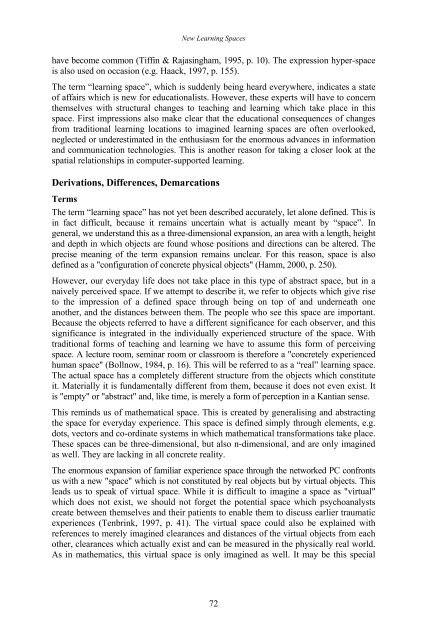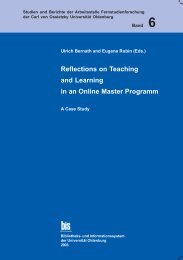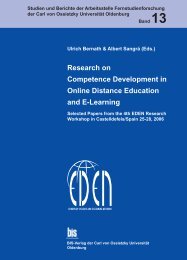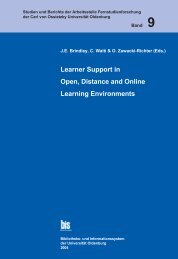Distance Education in Transition - Master of Distance Education ...
Distance Education in Transition - Master of Distance Education ...
Distance Education in Transition - Master of Distance Education ...
You also want an ePaper? Increase the reach of your titles
YUMPU automatically turns print PDFs into web optimized ePapers that Google loves.
New Learn<strong>in</strong>g Spaces<br />
have become common (Tiff<strong>in</strong> & Rajas<strong>in</strong>gham, 1995, p. 10). The expression hyper-space<br />
is also used on occasion (e.g. Haack, 1997, p. 155).<br />
The term “learn<strong>in</strong>g space”, which is suddenly be<strong>in</strong>g heard everywhere, <strong>in</strong>dicates a state<br />
<strong>of</strong> affairs which is new for educationalists. However, these experts will have to concern<br />
themselves with structural changes to teach<strong>in</strong>g and learn<strong>in</strong>g which take place <strong>in</strong> this<br />
space. First impressions also make clear that the educational consequences <strong>of</strong> changes<br />
from traditional learn<strong>in</strong>g locations to imag<strong>in</strong>ed learn<strong>in</strong>g spaces are <strong>of</strong>ten overlooked,<br />
neglected or underestimated <strong>in</strong> the enthusiasm for the enormous advances <strong>in</strong> <strong>in</strong>formation<br />
and communication technologies. This is another reason for tak<strong>in</strong>g a closer look at the<br />
spatial relationships <strong>in</strong> computer-supported learn<strong>in</strong>g.<br />
Derivations, Differences, Demarcations<br />
Terms<br />
The term “learn<strong>in</strong>g space” has not yet been described accurately, let alone def<strong>in</strong>ed. This is<br />
<strong>in</strong> fact difficult, because it rema<strong>in</strong>s uncerta<strong>in</strong> what is actually meant by “space”. In<br />
general, we understand this as a three-dimensional expansion, an area with a length, height<br />
and depth <strong>in</strong> which objects are found whose positions and directions can be altered. The<br />
precise mean<strong>in</strong>g <strong>of</strong> the term expansion rema<strong>in</strong>s unclear. For this reason, space is also<br />
def<strong>in</strong>ed as a "configuration <strong>of</strong> concrete physical objects" (Hamm, 2000, p. 250).<br />
However, our everyday life does not take place <strong>in</strong> this type <strong>of</strong> abstract space, but <strong>in</strong> a<br />
naively perceived space. If we attempt to describe it, we refer to objects which give rise<br />
to the impression <strong>of</strong> a def<strong>in</strong>ed space through be<strong>in</strong>g on top <strong>of</strong> and underneath one<br />
another, and the distances between them. The people who see this space are important.<br />
Because the objects referred to have a different significance for each observer, and this<br />
significance is <strong>in</strong>tegrated <strong>in</strong> the <strong>in</strong>dividually experienced structure <strong>of</strong> the space. With<br />
traditional forms <strong>of</strong> teach<strong>in</strong>g and learn<strong>in</strong>g we have to assume this form <strong>of</strong> perceiv<strong>in</strong>g<br />
space. A lecture room, sem<strong>in</strong>ar room or classroom is therefore a "concretely experienced<br />
human space" (Bollnow, 1984, p. 16). This will be referred to as a “real” learn<strong>in</strong>g space.<br />
The actual space has a completely different structure from the objects which constitute<br />
it. Materially it is fundamentally different from them, because it does not even exist. It<br />
is "empty" or "abstract" and, like time, is merely a form <strong>of</strong> perception <strong>in</strong> a Kantian sense.<br />
This rem<strong>in</strong>ds us <strong>of</strong> mathematical space. This is created by generalis<strong>in</strong>g and abstract<strong>in</strong>g<br />
the space for everyday experience. This space is def<strong>in</strong>ed simply through elements, e.g.<br />
dots, vectors and co-ord<strong>in</strong>ate systems <strong>in</strong> which mathematical transformations take place.<br />
These spaces can be three-dimensional, but also n-dimensional, and are only imag<strong>in</strong>ed<br />
as well. They are lack<strong>in</strong>g <strong>in</strong> all concrete reality.<br />
The enormous expansion <strong>of</strong> familiar experience space through the networked PC confronts<br />
us with a new "space" which is not constituted by real objects but by virtual objects. This<br />
leads us to speak <strong>of</strong> virtual space. While it is difficult to imag<strong>in</strong>e a space as "virtual"<br />
which does not exist, we should not forget the potential space which psychoanalysts<br />
create between themselves and their patients to enable them to discuss earlier traumatic<br />
experiences (Tenbr<strong>in</strong>k, 1997, p. 41). The virtual space could also be expla<strong>in</strong>ed with<br />
references to merely imag<strong>in</strong>ed clearances and distances <strong>of</strong> the virtual objects from each<br />
other, clearances which actually exist and can be measured <strong>in</strong> the physically real world.<br />
As <strong>in</strong> mathematics, this virtual space is only imag<strong>in</strong>ed as well. It may be this special<br />
72





